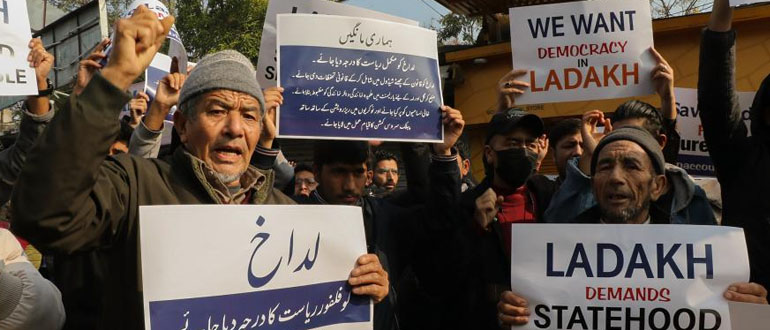Following the 2019 separation from Jammu and Kashmir, there was initial hope among the local population. However, the absence of an assembly and local representation created a sense that key decisions were being made in Delhi rather than in Ladakh. There is no effective constitutional or administrative framework to safeguard land, resources, employment, and cultural identity.
By Muhammad Jawad Habib:
Introduction:
Ladakh, with its towering mountains, unique culture, and strategic geographical significance, holds a distinguished place in the world. Yet, in recent years, this region has also become a center of political and social challenges. The protests of September 24, 2025, which resulted in the deaths of five individuals and injuries to dozens, highlighted that the issues here are not merely administrative. They are deeply intertwined with political, economic, and cultural complexities. Security measures alone or police action cannot provide lasting solutions; what is needed is a comprehensive political strategy, local representation, and active public participation.
Following the 2019 separation from Jammu and Kashmir, there was initial hope among the local population. However, the absence of an assembly and local representation created a sense that key decisions were being made in Delhi rather than in Ladakh. There is no effective constitutional or administrative framework to safeguard land, resources, employment, and cultural identity. This lack of participation has led not only to limited investment and job opportunities but also to long-standing frustration. Today, public demands are largely focused on statehood, constitutional protection under the Sixth Schedule, and local autonomy.
Rising Youth Discontent:
The youth of Ladakh are at the heart of this struggle. They are the guardians of their culture, language, and local identity, and perceive any external influence or rapidly changing population as a threat. A lack of political representation and the feeling that their voices are not heard leads to frustration and anger.
Economic deprivation further compounds the issue. Limited local employment opportunities push educated youth toward protests, and at times, even violent expressions of dissent. The absence of investment, skill development, and local opportunities heightens the risk of social unrest or migration, as young people feel that their talents and efforts are unrecognized.
Additionally, political marginalization fosters a sense of insecurity and exclusion, as locals are not included in key decision-making processes. These factors demonstrate that youth grievances are not merely emotional; they are deeply rooted in social, economic, and political realities. Harnessing their energy positively is essential for the region’s development, peace, and social cohesion.
Violence vs. Peaceful Struggle:
The events of September 24 demonstrated that prolonged neglect of legitimate demands can lead to emotional outbursts and violent incidents. However, labeling youthful anger as “illegal” oversimplifies the issue. Behind these reactions lie economic deprivation, lack of representation, and uncertainty about the future. Violence is not the solution; peaceful struggle remains the most sustainable, effective, and ethically acceptable path forward.
Addressing the Government of India:
Respected Government of India, the people of Ladakh urge your immediate attention to the following:
1. Statehood and Constitutional Safeguards: Local demands for statehood, Sixth Schedule protections, and greater autonomy should be addressed through transparent dialogue.
2. Economic Opportunities and Employment: Rapid implementation of employment programs, skill development initiatives, and local investment is essential to ensure economic self-reliance for the youth.
3. Support for the Injured and Families of the Fallen: Immediate financial, medical, and social support must be provided to those affected during protests.
4. Peaceful Dialogue and Welfare Measures: The protests should not be seen solely as a law and order issue but addressed as a political and social concern through dialogue and constructive action.
These measures will build trust, ensure social stability, and open the path for lasting peace and development in Ladakh.
Conclusion:
The youth of Ladakh represent the region’s greatest strength. If their energy is channeled through peaceful struggle, it can guarantee social, economic, and political progress. It is the shared responsibility of both the government and the local community to provide guidance, transparent representation, and economic opportunities.
The time has come to transform Ladakh into a region where peace, justice, and progress are assured for all, and where the youth dedicate their energy to building and development. Peaceful activism and positive youth engagement are the keys to a brighter future for Ladakh.



